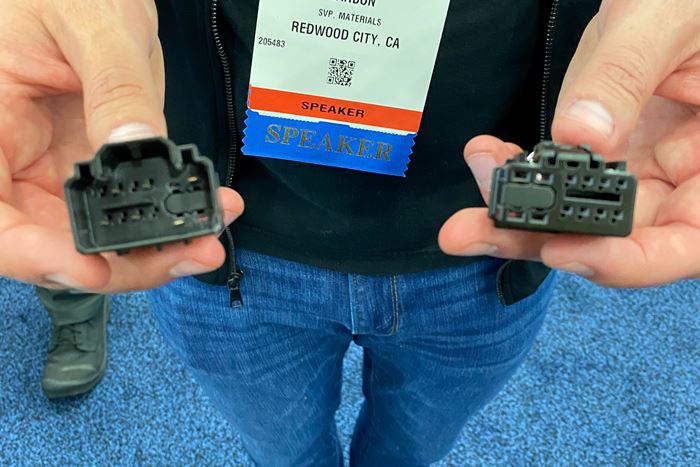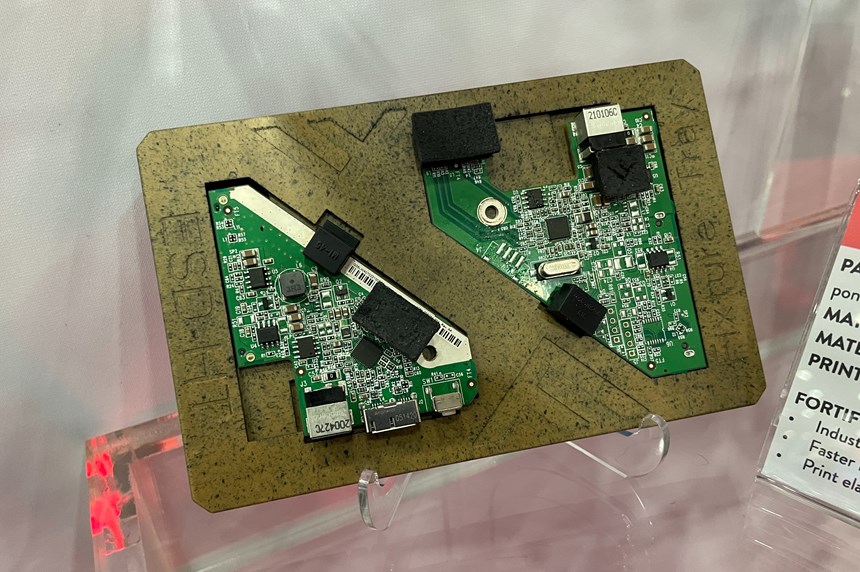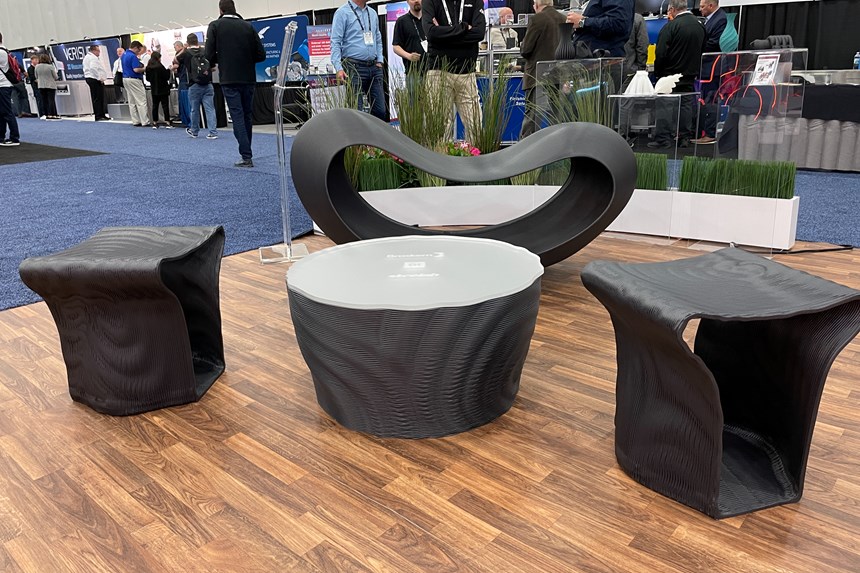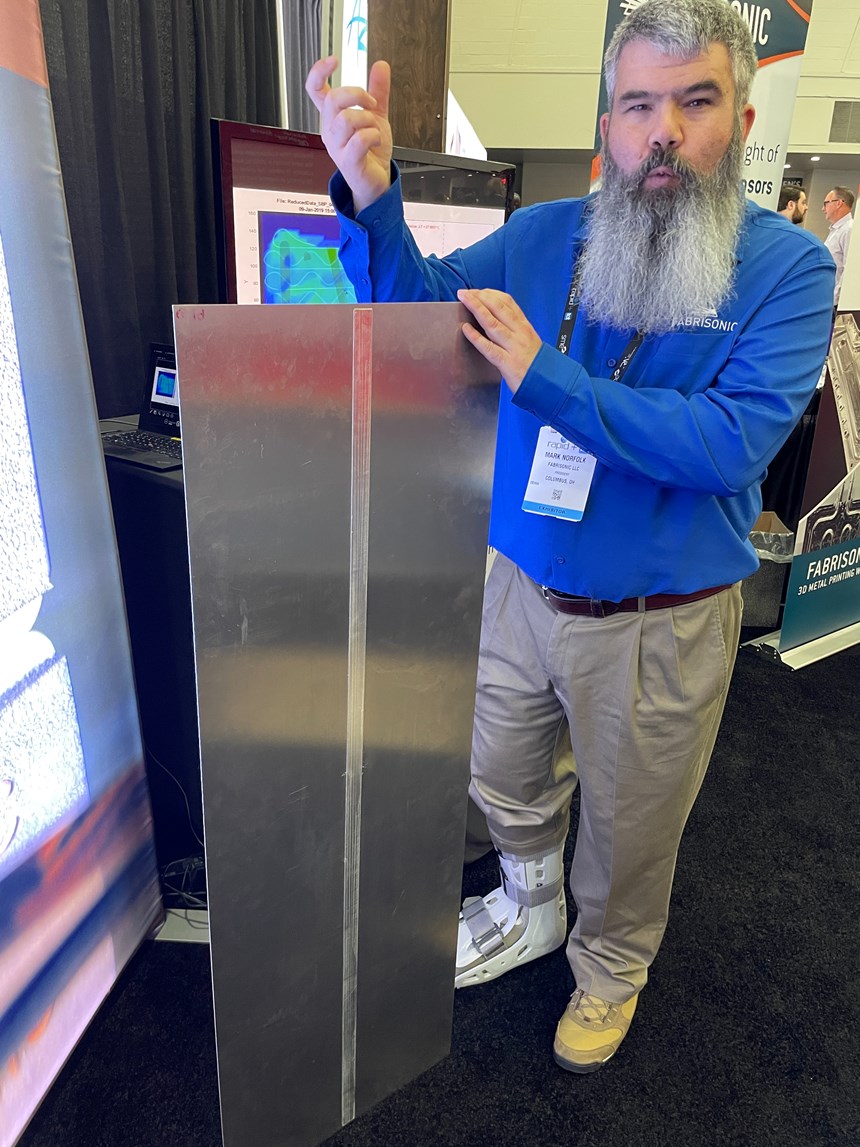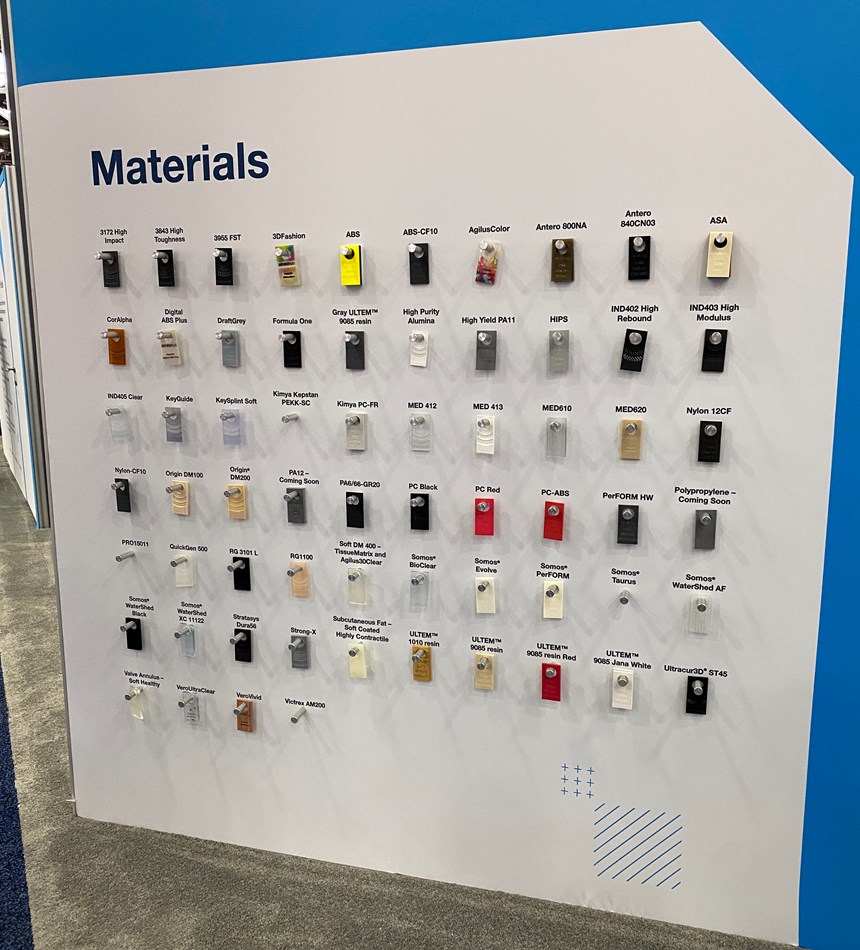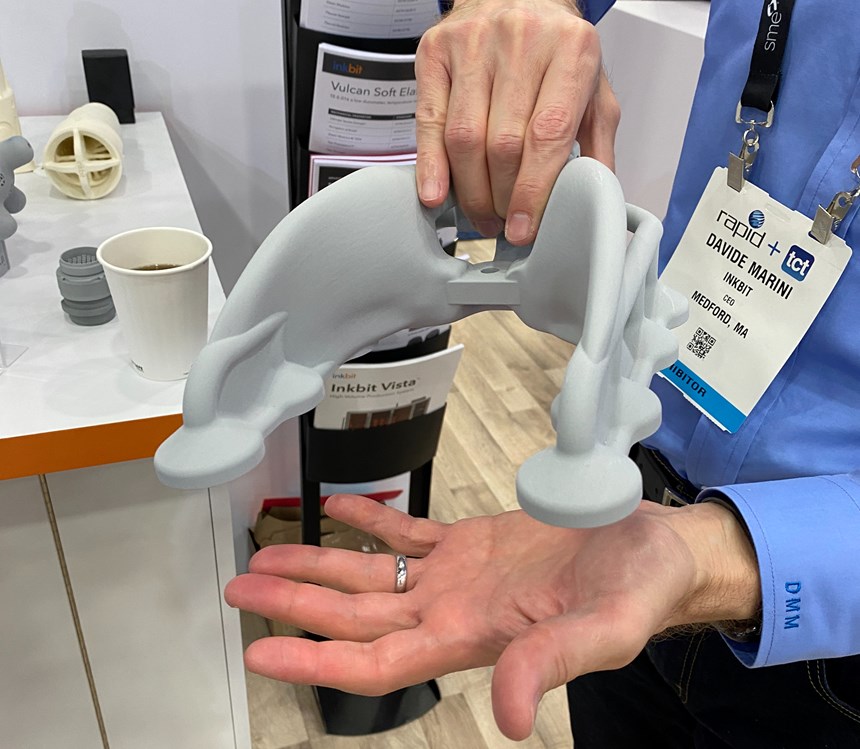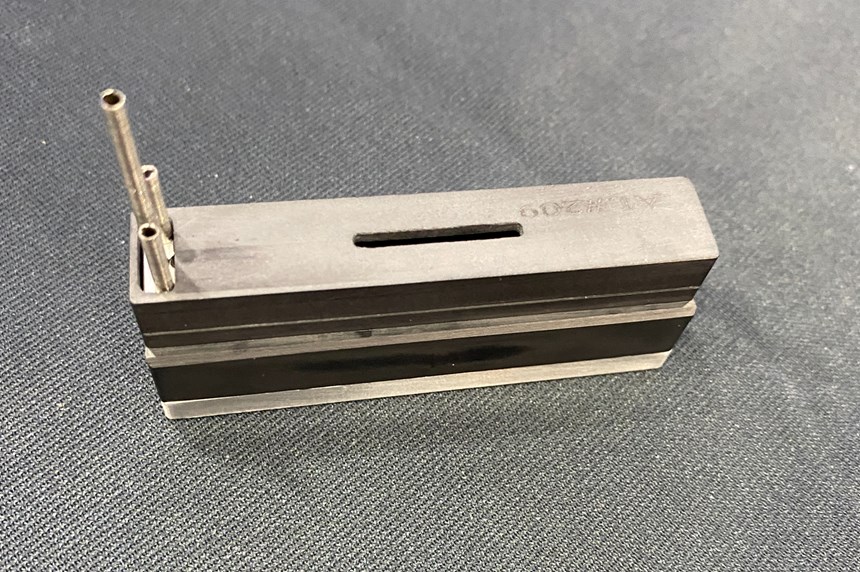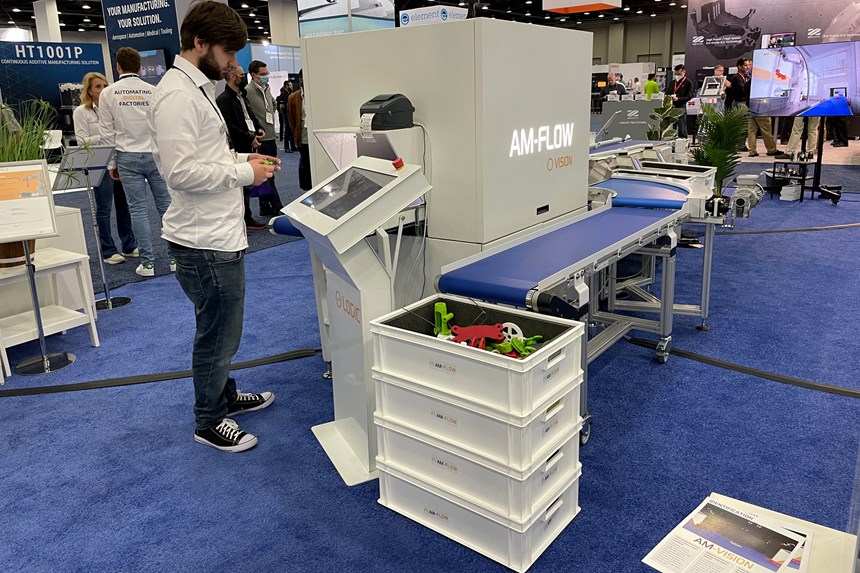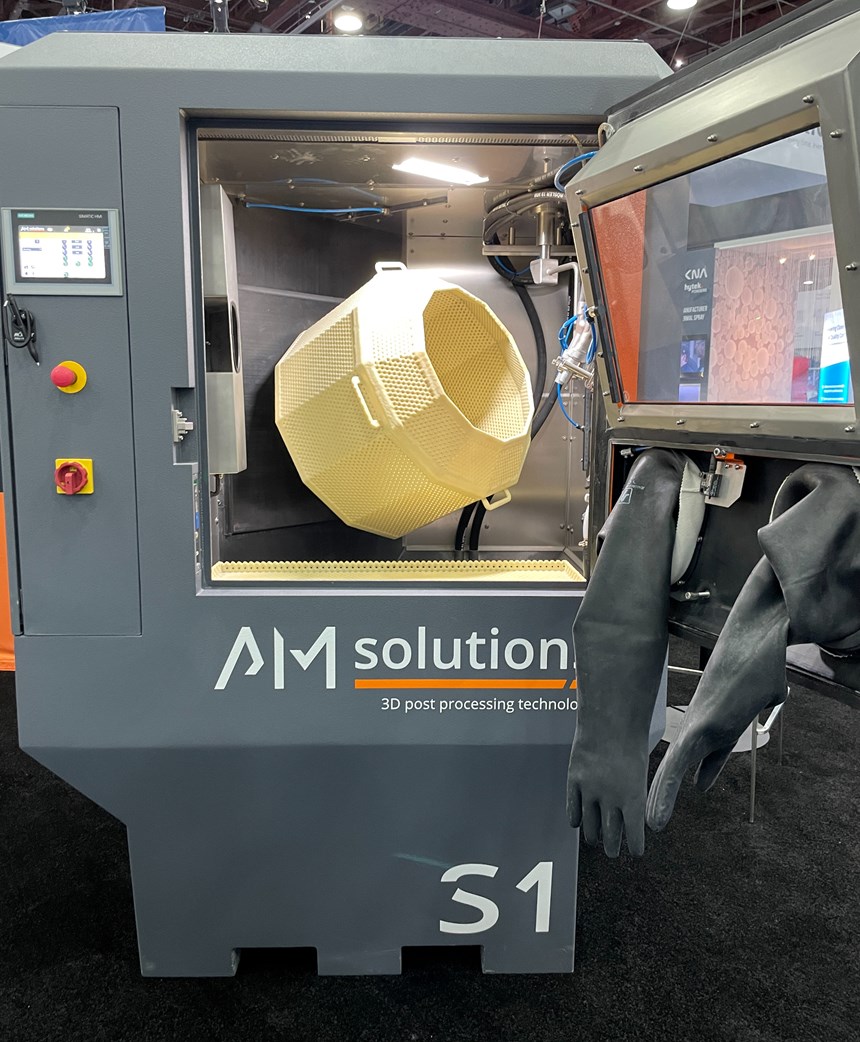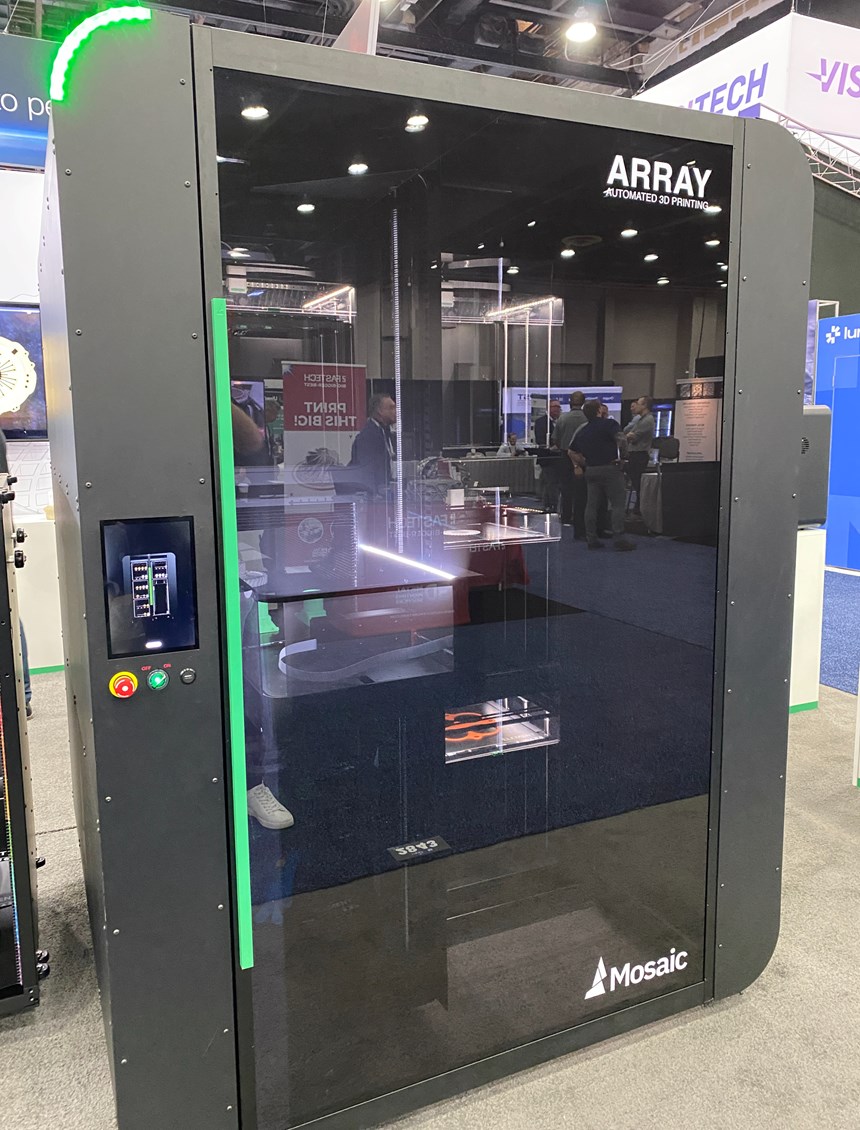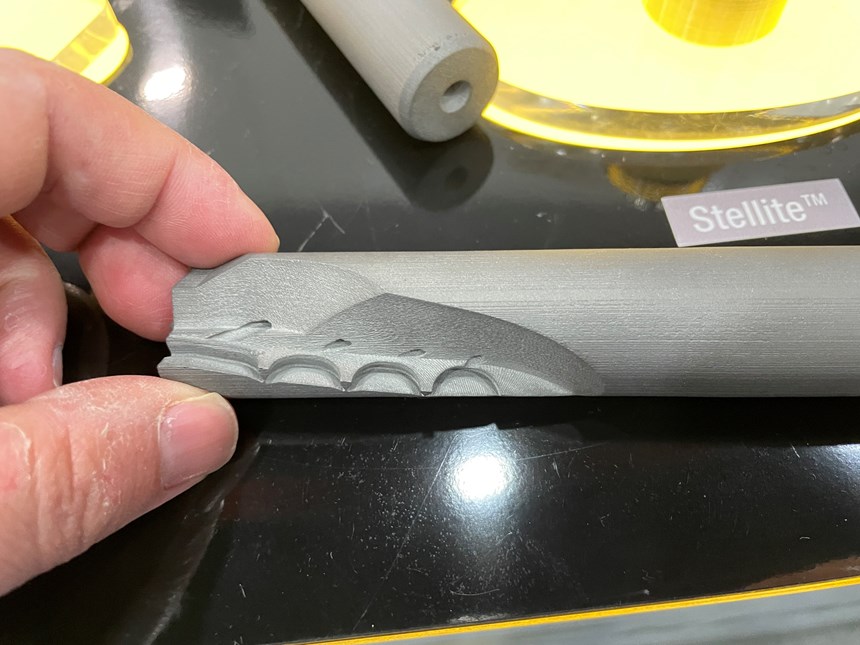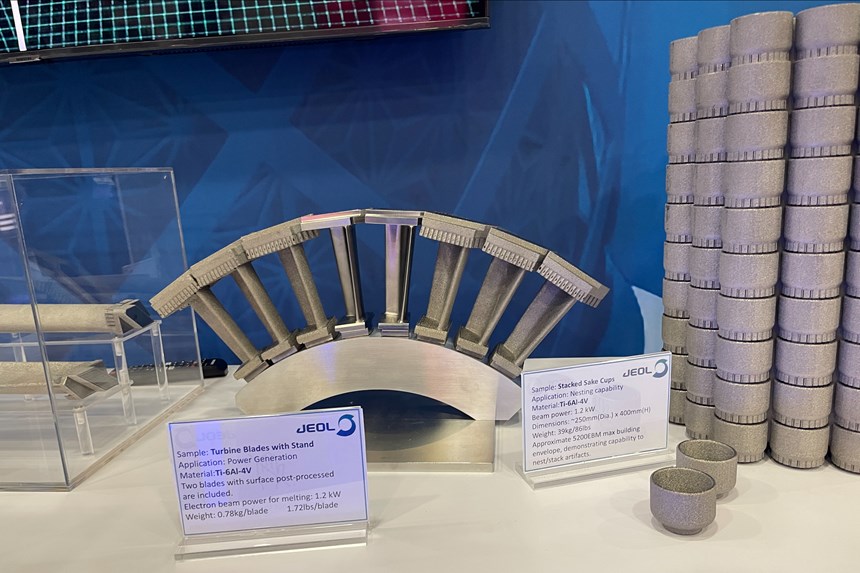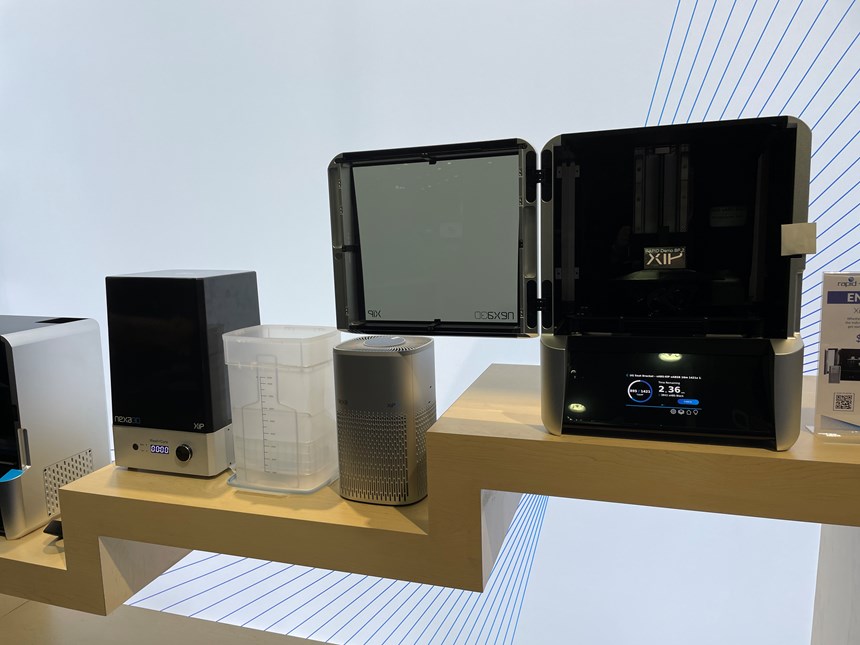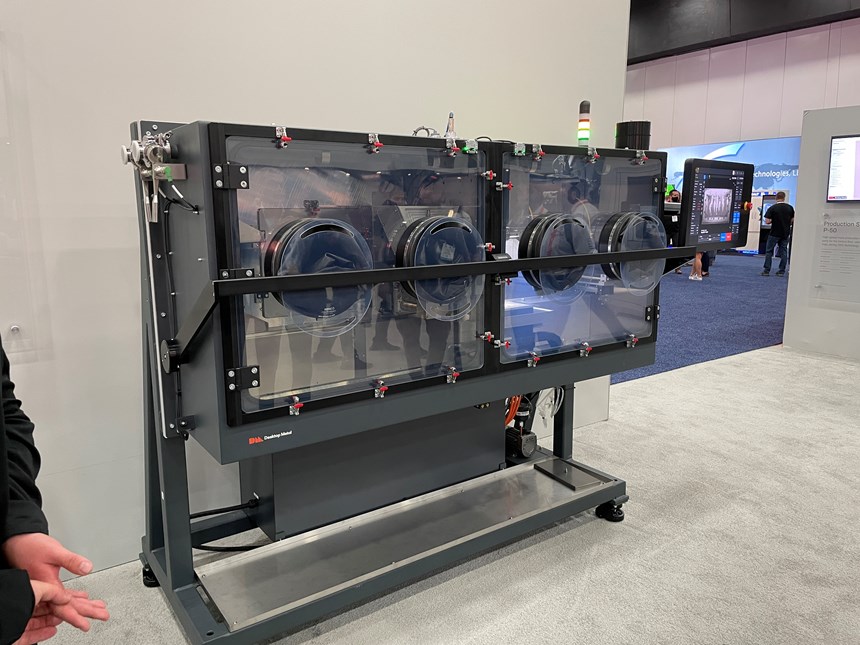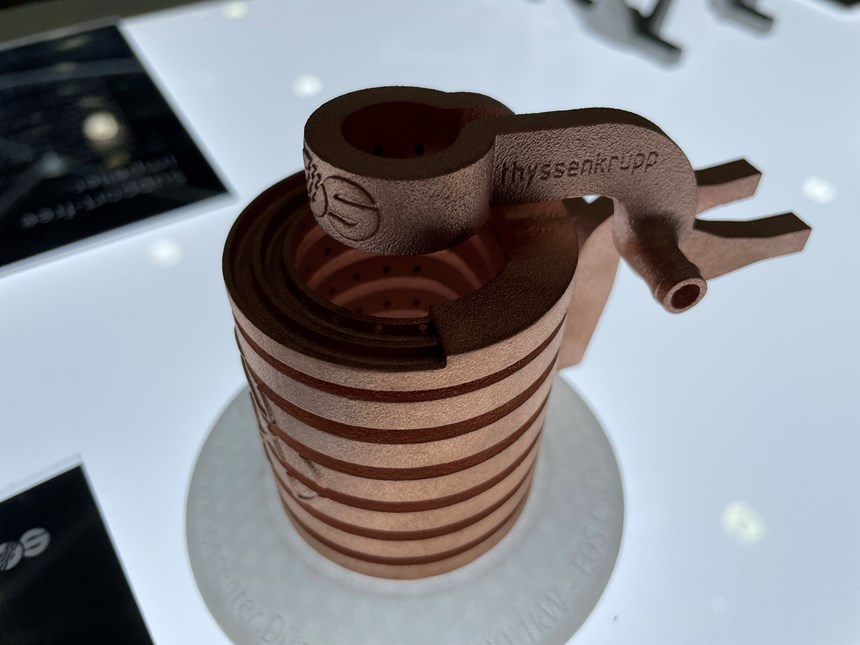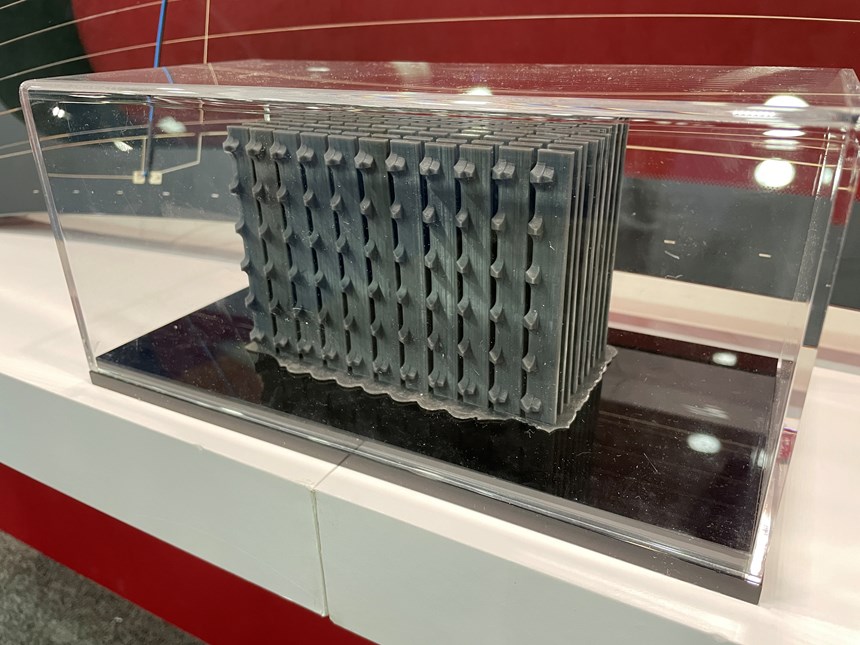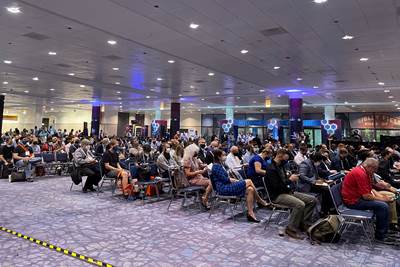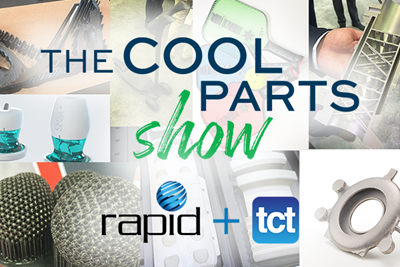The RAPID + TCT trade show returned to its spring timing for 2022. Held at Huntington Place in Detroit, the show included 381 exhibitors and three days of programming centered on 3D printing technology and additive manufacturing (AM). The last few years have changed live events, but they have also changed and advanced AM. Additive is moving into its next “season,” one that is more capable, more mature and more agile. Editors Stephanie Hendrixson, Peter Zelinski and Julia Hider attended the show; see photos from the event below and hear their discussion and takeaways in this episode of the AM Radio podcast (available embedded above and wherever you get podcasts, as well as transcribed below).
SCenes from Rapid + tct 2022
Stephanie Hendrixson
Welcome to AM Radio, the show where we tune in to what's really going on in additive manufacturing. I'm Stephanie Hendrixson. I'm going to be joined today by Pete Zelinski and Julia Hider. We're going to be talking about all things RAPID + TCT 2022. What we saw, the conversations we had, the trends we observed. That's all coming up on AM Radio.
Julia Hider
The AM Radio podcast is brought to you by the Additive Manufacturing Conference at IMTS. The leading industry event focused on 3D printing for production. Learn more at AdditiveConference.com.
Stephanie Hendrixson
Hello, and welcome to the show. I'm Stephanie Hendrixson with Additive Manufacturing Media. I'm joined today by both of my cohosts, Pete Zelinski.
Peter Zelinski
Hi, Stephanie.
Stephanie Hendrixson
And Julia Hider.
Julia Hider
Hey, Stephanie.
Stephanie Hendrixson
We are recording this on Friday, May 20. We just got back from RAPID + TCT 2022 in Detroit. And so it's very fresh in our memories. And just wanted to have a conversation with you about the things that we saw. I think we have about five big ideas we're going to talk about today. But I think we should just maybe start by talking about the show what it was like what it felt like.
Peter Zelinski
RAPID + TCT. So biggest event in America focused on 3D printing. Stephanie, you just gave me a few minutes ago, the number of exhibitors that were there, 300 and something?
Stephanie Hendrixson
381.
Peter Zelinski
Yeah, and this feels far and away the most return to normal additive trade show we've had so far. Absolutely.
Julia Hider
Yeah, like I said, in our last RAPID recap, I've never seen a pre-covid RAPID, but this definitely felt more like a normal trade show.
Peter Zelinski
The show was busy. And in spite of sort of the quick turn since the last version of the show, it felt different. And we can see ways that the tone of this space and the tone of additive manufacturing adoption and sort of the conversations around it, we can kind of see new, like new seasons emerging in the advance of this technology and its application, I think, in this conversation that'll come out. And that's what we're going to talk about.
1. Additive Manufacturing Shores Up Supply Chains
Stephanie Hendrixson
Yeah, so New Seasons in additive. I think maybe we'll just jump right into our first discussion topic. So I think the first one we want to talk about is using additive as a way of shoring up reinforcing filling gaps in supply chains. An example right off the bat came Tuesday morning like in the sort of lead up to the keynote. John Dulchinos from GKN gave this example of these parts for a GM SUV. And there were like, 30,000 of these cars waiting for this part. It's a seal; there's two on each car, and they had to make some design changes to improve the aerodynamics and the fuel economy of the vehicles. And the situation was that the lead time for a mold for these parts was something like 12 weeks, and GKN instead printed them using Multi Jet Fusion. They printed them with TPU and vapor polished them and delivered those parts in about six weeks. So this was this case where there was a gap in the supply chain caused by that lead time and 3D printing jumped right in and solve that problem. But I think we saw other examples of that at the show as well.
Peter Zelinski
Additive as an answer for shortcomings and vulnerabilities in the supply chain. Like the thing that became clear at the show this year is that's not just hypothetical, like we started talking about that during the last couple years, as we saw the role that 3D printing was sort of thrust into in the response to emergency medical supplies. And the supply chain disruptions that we're seeing can additive play a role there, what you're describing with GKN, it was it was additive stepping into a place where the supply chain couldn't respond to an unexpected need.
What I kept encountering in different conversations was evidence of how the technology suppliers and the process suppliers in additive are being asked to respond to this, are being asked to provide kind of supply chain buffers and insurance policies to kind of introduce a new way of thinking about industrial supply. This overarching context of thinking about supply chains have a role for additive manufacturing within shoring up supply chains.
It's leading to kind of a change in vocabulary, a phenomenon I kept noticing throughout conversations this week, the word sustainable, the word sustainable is getting used in two different contexts in ways that sometimes you have to kind of check and listen for a moment to know which context of that word you're talking about. So this this particularly came out in a conversation with Jabil talking with Matt Torosian, a product director and and Luke Rodgers, director of R&D, so they're talking about a new material they developed for selective laser sintering, their PK 5000 polyketone material, it consumes carbon monoxide, so it's environmentally friendly and also It can provide an alternative to PA12. So it offers supply chain redundancy. So, Matt Torosian, and in particular listening to him talk about this material, he used sustainable in rapid succession two different times talking about these two different things that need to be sustained. There is the very real issue now of supply chain sustainability, alongside the ongoing phenomenon of environmental sustainability and additive speaks to that to additive is now speaking to both of these areas of concern and vulnerability,
2. Polymers Engineered for Specific Applications
Stephanie Hendrixson
Right. So like, there's this duality of what sustainable means. Is it the environmental sense? Is it the supply chain sense? Can it be both at the same time? So you mentioned this conversation with Jabil, and I was there in the booth with you as well. And that makes me think of the next big topic we want to address. And that's this idea of polymers being engineered for specific applications. So Jabil showed us another material that they had created. And it's a custom proprietary formulation that was developed specifically for KAV, this company that makes custom bike helmets. And so they sort of talked about how they worked directly with the customer on, you know, what are the particular demands of this application? How can we 3D print a bike helmet that's going to meet the regulatory requirements that it needs to? How can it also look nice, and they were able to develop this material? I think it took about six months. And it's something that only this customer is using, it's something that was created specifically for them and specifically for this application.
Julia Hider
Yeah, so one of the more interesting examples I saw, this was in Carbon’s booth, and they were showing a material called EP X 86 FR, which is a flame-retardant photopolymer resin, and it was designed for electrical applications like connectors, and covers and housings. And it's actually self extinguishing. So they had a video where they set the part on fire, and then when they moved the flame away from the part it stopped burning. So that was a really interesting example of that, that I saw.
Stephanie Hendrixson
That is amazing. I love it.
Peter Zelinski
Yeah. So there is this opportunity with additive for materials and polymer materials, in particular, to achieve these extreme combinations of design requirements. And that is an important freedom with additive. In EOS’s booth, I was having a conversation that ended up kind of framing this, I was talking to Greg Hayes, and he's a he's a technology VP with EOS. And he's really seeing this play out and to hear him talk, it's like there's this third phase we're entering into now with polymer additive manufacturing. So first phase, polymer 3D printing was making prototypes, then there was material development of materials suited to functional end use parts. And we found all the production applications we could that could take advantage of those materials. So for example, like with the EOS case, so they're their nylon product, PA 2100, nylon for selective laser sintering. So it's like a workhorse material, and there are all these applications. But now there's this, this new phase of customers coming to these companies providing polymer additive systems, looking for specific solutions that the design freedom begins with the material freedom. And so like a material like that, PA 2100, like that'll still be a workhorse but the percentage of applications relying on that material is going to go down as additive realizes this promise of materials customized for applications.
Stephanie Hendrixson
That's true. That reminds me of another conversation I had, I was in the Braskem booth talking to Jason Vagnozzi, who is the global director for additive manufacturing. And so Braskem is this materials company, which existed long before additive manufacturing, but they now have a number of products specifically for 3D printing with filaments with powders. And one of their specialties is polypropylene, like this is a material that has been difficult to print in the past. And they've sort of figured out the right way to formulate it the right way to process it to help customers actually use it. And one of the examples that they had in their booth was a mold. That was for like a like a shoe sole. And the polypropylene kind of gives you an option in between something like PLA that's not going to last very long as a low volume mold, or something that's nylon or made out of metal, something that might actually be like over-engineered for what you need. And so the third phase of 3D printing materials development that we're in right now, I think part of the result of it might be like we're getting to a place where you can sort of right size the material, you don't have to over engineer it because nylon is the only thing available that can do what you need it to do. We're getting more options. We're getting more in-between choices.
Peter Zelinski
Wow. So it's not just extreme properties, like the flame resistance that Julio was describing with the carbon material. It's also getting the full economic benefit you can by getting just the properties you want and no more than that.
Stephanie Hendrixson
That's right. I think that one of the other things that I noticed in their booth and actually that they were they were highlighting is how materials development tends to not happen in isolation. We're seeing more and more companies develop materials in combination with customers, we're seeing more just collaboration overall. And I think that's something we're going to get into in the second half of the show, right after this.
Julia Hider
The AM Radio podcast is brought to you by the Additive Manufacturing Conference at IMTS, the leading industry event focused on 3D printing for production. Collocated with North America's largest trade show dedicated to manufacturing equipment, the AMC takes place September 14 and 15th at Chicago's McCormick Place. The conference takes a practical, applications-based look at the machines, materials and methodologies being used to 3D print functional components, including both tooling and end-use production parts. The event is designed for owners, executives and engineers, as well as OEMs involved in durable goods manufacturing. Join the Additive Manufacturing team in Chicago for a day and a half of conference sessions and networking opportunities, find more information and register at AdditiveConference.com.
3. Partnerships and Collaboration in Additive Manufacturing
Stephanie Hendrixson
And we're back. I'm Stephanie Hendrixson. I'm talking with Pete Zelinski and Julia Hider, about all the different things that we saw and observed and learned at RAPID + TCT this week. In the first half of the show, we talked about additive as a means of shoring up supply chains, as well as polymers engineered for specific applications. And one of the points that came out was this idea of partnerships, collaboration, and companies working together. And I think Julia, you have an example that that touches on this.
Julia Hider
Yeah. So last week, the week before the show, Stratasys announced its first third-party validated materials. So they had a wall in their booth with samples of all these different materials to kind of showcase that. And I was able to speak with the company CEO, Dr. Yoav Zeif, about this strategy. And he said that their focus right now is on increasing mass adoption by focusing on the best use cases. And part of that is supporting customers with the right materials.
Stephanie Hendrixson
And that's a big deal for Stratasys. In years past, like their systems were pretty closed, it was hard to use third-party materials; the fact that they're coming out with these partnerships and wanting a more open materials philosophy is really interesting.
Peter Zelinski
I guess what that makes me think of we've been talking about polymers for a few minutes. Now I had a chance to sit down with GE Additive, and Kennametal, who are partnering on tungsten carbide 3D printing, exploring the further development of binder jetting to make parts from tungsten carbide, very hard wear resistant material. Like a lot of things were striking to me about that. But one of them, big, big picture, is just these are two such well-established industrial companies — GE, Kennametal, longtime tooling maker in machining — that they are not just individually pursuing the development of additive technology, but also kind of joining forces seeing the opportunity in 3D printing of this particular industrial material for industrial components. It just sort of speaks to kind of the arrival of additive manufacturing, is this getting to be mainstream production process for industrial parts?
Stephanie Hendrixson
Yeah. And I want to throw out one other kind of example of partnerships and collaboration, getting us out of sort of the the tangible stuff. So I spoke with Materialise. This was one of my first meetings of the show. I talked with Brian Crutchfield, who's the vice president and general manager. And they've just launched this initiative called CO-AM, and it's an open software platform. It's designed to manage all of your additive manufacturing workflows. And so they're just being very tech agnostic, very open with this, and allowing other partners to kind of feed their software capabilities into this system. So everything from design and build preparation through your postprocessing, and like shipping and logistics could be handled through one single platform. They've got some initial partners that they've announced, including Castor, which helps you identify parts suitable for 3D printing, all the way through AM-Flow, which is for automation, like once you have those parts, how do you sort them? How do you get them where they need to go? And so it's a solution that is going to require a lot of different parties coming together. But it's going to potentially be very powerful, and everything is going to feed into what they're calling the data lake. So they're going to be able to collect information about every part, every batch, and use that over time to learn from and improve the process. So there's going to be like an AI kind of element into this to help improve additive manufacturing as well as manage additive manufacturing,
Peter Zelinski
Data lake?
Stephanie Hendrixson.
The data lake.
Peter Zelinski
So there're like rivers of data flowing into it?
Stephanie Hendrixson
It was not described to me as such. But yeah, I think you could picture it that way.
Julia Hider
Why a lake and not an ocean, though? I mean, I've heard that term before. I just —
Stephanie Hendrixson
It's a good question. Maybe we will get to the data ocean. But speaking of things flowing and moving into larger, larger bodies —
Peter Zelinski
Is that what we're speaking of?
Julia Hider
Good job Stephanie.
Stephanie Hendrixson
This is the transition I'm gonna go with. Getting back to more of more of the technology level thing. I think we also saw some interesting developments in one particular type of additive manufacturing. And I'm talking about material jetting.
4. Advances with Material Jetting 3D Printing
Julia Hider
Yeah, so I visited Inkbit, which I've written about I mentioned on the show before, but they're a startup that has a material jetting machine that uses machine vision and AI to jet more viscous materials. But they just shipped their first machine to St. Gobain’s R&D facility. They didn't really know or couldn't say too much about what the machine will be used for. But it'll be interesting to see what applications come out of that.
Peter Zelinski
We've seen this in past years and past shows these various different additive processes, what they do what they can do, it changes, there's still development underway, material jetting as a concept has existed for quite a while. But [Inkbit] is an example of a company they've refined the technology taking it to a new place. And suddenly, it's an option for production that it wasn't before.
Stephanie Hendrixson
So I spoke with a materials jetting company, as well. Actually, Julia and I were in this booth at the same time but having different conversations. And we both visited Quantica. And they have a printhead for high-viscosity material jetting, they are able to 3D print with SLA and DLP materials, basically just off the shelf. And so what we've seen kind of historically with some other material jetting technologies is that the materials, they look great, like you can get really nice looking, like full-color models out of them. But the properties aren't very durable. Like they're not very good for actual functional parts. And so because they're able to jet these more viscous, more high performance materials, you can get actual durable prints out of this and use multiple materials at the same time. So the example they had in their booth was like a set of dentures where you could print the gums and then print the teeth right on top. And it's all one part. And it's durable enough to be used, but then print it all out once. But I'm speaking with Marcel Stobel, who's the COO of the company, and he was talking about, you know, where this system might go in the future, like, they have ambitions to be able to get even smaller to be able to print things like PCBs, so circuit boards. And he made the point that, you know, there are a lot of things in the world right now that are the way that they are just because manufacturing means that they have to be that way. And maybe if we're able to do things like 3D printed circuit boards in 3D, we could change the way products are. And so like a hearing aid doesn't have to be exactly the shape it is, it's that shape, partly because the circuit board is flat inside. And if you could 3D print it, you know, on a curve or with a different geometry, maybe you could change the shape of a product and make it suit the user better.
Peter Zelinski
Yeah, different fundamental choices in the way we make things. So what that makes me think of — XJet was also innovating in the area of material jetting, and their process is NanoParticle Jetting. And it has to do with depositing material using very, very fine particles, and they were showing a lot of ceramic components. And in a conversation there, they sort of drew my attention to that. Ceramic is this really great material, it's got all these properties we really need. It's heat resistant, it is an electrical insulator, it is lightweight, it's hard, it is inert, you can put it in the body. It has all these properties we value it's just super hard to work with. The molding process for ceramic is challenging, and it is all but impossible to machine when it's in its fully hardened state. So XJet with their NanoParticle Jetting is a way to get very fine tolerance forms in ceramic and that means a practical way to get ceramic components ceramic parts that we never would have thought were candidates for this material before. Yeah, additive manufacturing, like we've been talking about materials in this conversation, additive keeps coming back to materials as the core opportunity and the core issue. And one other benefit of material jetting could be a world in which a whole lot more stuff is very beneficially made out of ceramic.
5. Bringing Additive Manufacturing to Scale Production
Stephanie Hendrixson
So yeah, that's true, like materials have been this, this challenge that additive manufacturing keeps running up against. But I had this interesting conversation in the AM-Flow booth. So speaking with Carlos Zwikker, who is the commercial director there, and he made this point that additive is sort of advancing bottleneck by bottleneck. So we sort of started with, you know, the printer like the actual hardware, like can you get this process to work, and then we got to the materials and like, we've advanced pretty far there. It's still ongoing, obviously, but that was kind of the next thing. And then we hit the software bottleneck. And now we're sort of somewhere in between, like the postprocessing challenge, and we're moving into this need for greater automation greater repeatability built into the process.
And so I think that connects to what our last point is going to be bringing additive manufacturing into scale production and sort of where we're at with that. AM-Flow is an automation company, they're looking at this on sort of like the downstream end of things like how can you sort parts after you've printed them? You have a big batch of like Multi Jet Fusion or SLS parts, and you've got to divide them up and some needs to be dyed, and some need to be blasted, and some need to just go straight into shipping. And so they were showing this conveyor that sorts parts in that way, it's a solution for how to do high-mix, low-volume or high-mix, high-volume production via 3D printing.
Peter Zelinski
That is so interesting, that model you've described about how this this space, the sector, additive manufacturing has proceeded bottleneck by bottleneck, maybe I could take that model a little further. And I think in every successful production application in their own way, they've had to go bottleneck by bottleneck. You look at a part design, and it might be intuitively obvious, or a conclusion that's arrived at pretty quickly that yeah, this should be made additively. That could be clear. But there are all these little devil in the details, things to work out to get to this robust ongoing production solution for that particular part. And it's their own version of bottleneck by bottleneck and, and maybe the problem they face it relates to postprocessing or leads to handling somehow or relates to consistency somehow. But the users are solving these problems. And I think the evidence of that is something that made this version of RAPID + TCT distinctive, the 2022 version of this show distinctive, and it is how commonplace production applications are getting to be. And I think what it speaks to is, there have been all of these different production applications kind of bubbling under the surface for quite a while now. And enough of those have been realized and enough of those who have broken through the surface, that it's not novel and noteworthy and interesting to go to a booth at a show like this and see production parts there. It's sort of expected now. And it's happening now. And it sort of speaks to like, we're at a different place. And in fact, we're going to face now the next family of bottleneck challenges.
Stephanie Hendrixson
Yeah, I think that tracks with my experience of the show. Like I didn't meet with all that many like machine builders, I was meeting with people who are trying to figure out those next bottlenecks. So AM-Flow’s an example. AM Solutions, which is sort of a spin out of Rosler that does mass finishing and cleaning technologies, they've got new solutions for cleaning supports from polyjet prints, for glass bead blasting of other polymer parts. And like the assumption is that this is going to be a high-volume application, like there are going to be people who need this type of automated equipment. And they're anticipating that in particular ways specific to additive manufacturing.
Julia Hider
Yeah, so Stephanie, you've talked about some examples of automation on the postprocessing side. But on the printer automation side, I checked out the Mosaic booth, and they have a machine called the Array which they describe as an automated print farm in a box. So it has four FDM printers and a gantry system that unloads the finished parts onto a cart. And there are sensors and cameras integrated to detect fails, and a software system that can reroute the jobs if needed. And all of this together can allow the machine to run for, you know, three to four days or maybe even as long as two weeks depending on the type of part. And I made a video about this on the show floor that we posted on social media. So you can check that out to see it in action.
Stephanie Hendrixson
So you just mentioned, I think, three of the however many there are bottlenecks right there, like the hardware, the software and the automation, like all coming together.
Peter Zelinski
Mosaic system, like the printer is a given. It's the system in which the printer functions that we're going to have to work out now. Because the demand for scale. That's the challenge that's coming.
Stephanie Hendrixson
I've got one more example that connects directly to that. So United Performance Metals, UPM. This is the company in Hamilton, Ohio, not that far from our office in Cincinnati, that hosted President Biden a couple of weeks ago when he was announcing the aim forward initiative. And they're a really interesting company because they do almost everything for metal am except actually 3D printing in metals. They manufacture the build plates, they resurface the build plates, they do part cut-off, they do some postprocessing, some machining services, they're going to bring heat treat in-house, and their entire business is just like we're going to take care of all of these auxiliary steps for you. We're going to manage the lifespan of your build plates. We're going to track how long they've been in use, how many builds they've been through, we're going to swap them out for you. Like, all you have to do is worry about 3D printing the parts and we will take care of all the behind the scenes stuff. And like that as a service, like I didn't realize there was a demand for it, but there is a demand for this service. Production is here. And we need like these support things to really bring it to full scale.
Peter Zelinski
That is amazing. Additive manufacturing as a an industrial-scale manufacturing process and the arrival now of industrial service providers to take care of the aspects and needs of that ongoing production. Let me come back to something I mentioned before that I think paints a picture of this. GE Additive and Kennametal recently announced this, this collaboration, they've joined in around additive manufacturing of tungsten carbide components, not for cutting tools necessarily, even though Kennametal is well-known as a cutting tool company, there will be some of that, and maybe more and more of that, but more for where components in very different sorts of industries tungsten carbide components for the oil and gas industry, for defense. And so I sat down with both companies together and talked about that. And I was with Brian Birkmeyer. He's with GE Additive. He's a product leader with binder jet. And Jay Verellen, who's an additive manufacturing manager with Kennametal, and the things they were talking about, and the things they're concerned with is not how do you 3D print this metal? How do you do additive manufacturing with this material, which is where the conversation would have been two or three years ago, which is where all the conversations were as recently as two or three years ago. But they've got that down. Now they have demonstrated effective, consistent, repeatable 3D printing in tungsten carbide. That's not the concern. Now the concern now is issues of scale, in this partnership between these companies, that's what they're focused on. That's what their collaboration is all about. So they already know how to do it, how to make parts additively out of tungsten carbide, but the issues now are, how do we do it with more speed? How do we do it with even tighter repeatability? How do we do it as economically as possible? Like these are the challenges of scale? This is what additive manufacturing is getting to be all about.
Stephanie Hendrixson
A more sophisticated way of thinking about production through additive and how to improve the process now that it is established. Now that we know how to 3D print, how do we make it better?
I think we will end on that. Check out the show notes for links to things that we talked about. We took a lot of great photos at the show. We have a lot more to share. So we have a blog post on our website AdditiveManufacturing.Media and we'll link to that as well. Thank you for listening.
Peter Zelinski
AM Radio is recorded with help from Austin Grogan and Seth Cooper. The show is edited by Alex Lytle and Stephanie Hendrixson. Our artwork is by Kate Bilberry. AM Radio and Additive Manufacturing Media are products of Gardner Business Media located in Cincinnati, Ohio. I’m Pete Zelinski. Thanks for listening.
Related Content
Video: 5" Diameter Navy Artillery Rounds Made Through Robot Directed Energy Deposition (DED) Instead of Forging
Big Metal Additive conceives additive manufacturing production factory making hundreds of Navy projectile housings per day.
Read MoreDMG MORI: Build Plate “Pucks” Cut Postprocessing Time by 80%
For spinal implants and other small 3D printed parts made through laser powder bed fusion, separate clampable units resting within the build plate provide for easy transfer to a CNC lathe.
Read MoreWhy AM Leads to Internal Production for Collins Aerospace (Includes Video)
A new Charlotte-area center will provide additive manufacturing expertise and production capacity for Collins business units based across the country, allowing the company to guard proprietary design and process details that are often part of AM.
Read More3D Printed Titanium Replaces Aluminum for Unmanned Aircraft Wing Splice: The Cool Parts Show #72
Rapid Plasma Deposition produces the near-net-shape preform for a newly designed wing splice for remotely piloted aircraft from General Atomics. The Cool Parts Show visits Norsk Titanium, where this part is made.
Read MoreRead Next
Impressions and Trends from RAPID + TCT 2021: AM Radio Bonus
Peter Zelinski, Stephanie Hendrixson and Julia Hider discuss what they saw, heard and learned at RAPID + TCT 2021 in a special episode of the AM Radio podcast plus slideshow.
Read More8 Cool Parts From RAPID+TCT 2021: The Cool Parts Show #32
North America’s largest AM trade show resumed! Here are some of the coolest cool parts we found.
Read MoreBike Manufacturer Uses Additive Manufacturing to Create Lighter, More Complex, Customized Parts
Titanium bike frame manufacturer Hanglun Technology mixes precision casting with 3D printing to create bikes that offer increased speed and reduced turbulence during long-distance rides, offering a smoother, faster and more efficient cycling experience.
Read More

.jpg;width=70;height=70;mode=crop)





